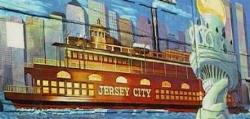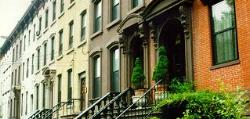 |  |  |
|
| ||
 |  |  |
 |  |  |
|
| ||
 |  |  |

 |
 |

Originally published in 1939
Some of this information may no longer be current and in that case is presented for historical interest only.
Edited by GET NJ, COPYRIGHT 2002
Shiloh-Roadstown-Greenwich; unnumbered roads.
The road runs through undulating farm country toward the Delaware
River, penetrating an area where Quaker settlements were made by John
Fenwick in the 1680's. There are many eighteenth-century houses along
the route.
The Roadstown Rd. branches south from State 49 (see Tour 29) at
SHILOH, 0 m. (120 alt., 401 pop.) (see Tour 29) and winds past fertile
farm lands tilled by Seventh-Day Baptists. Houses are usually of brick,
sometimes coated with paint or stucco.
The HOWELL HOUSE (private), 1.5 m. (R), was the rendezvous of the
young men of Cohansey who organized the Greenwich Tea Party to destroy a British cargo (see below). This stone dwelling was occupied just
prior to the Revolution by the twin Howell brothers, later active in the
Continental Army. One of them, Richard, became Governor of New Jersey (1792-1801).
ROADSTOWN, 1.6 m. (110 alt., 220 pop.), is the home of the Ware
family whose hand-made chairs, widely known for more than a century,
are popular with collectors of old American furniture. The method of
weaving rush seats is a closely guarded secret. At the center of Roadstown
is the COHANSEY BAPTIST CHURCH, founded about 1737, a brick structure in a grove of sycamore trees. This structure replaced a former log
building erected near Sheppard's Mill (see below).
SPRINGTOWN, 3.8 m. (30 alt.), together with the neighboring hamlet of OTHELLO (R), has been a Negro settlement for more than a century. Amateur architecture and carpentry prevail in the small, weather-
beaten, unpainted homes. The small wooden school and still smaller
church at the crossroads are the only buildings that bear evidence of continued use. Each house is surrounded by fields where farming is intermittently attempted. The residents are practically all workers on the nearby
farms. Springtown was established shortly after the Revolution to provide
living quarters for the Negro farm hands coming in from the South. It
was a station on the Underground Railroad during slave days.
Left from Springtown on a graded road is SHEPPARD'S MILL, 0.7 m., where
a large, white MILL beneath old trees has been in continuous operation for more
than 125 years. It obtains power from a large millpond (L) and an overshot water
wheel.
At 6.4 m. the road turns L. becoming a wide, graveled highway, the
"Great Road" included in the original plans of Greenwich made by surveyors for John Fenwick in 1683. The road is about 2 miles long; for
much of its length it is l00 feet wide.
GREENWICH, 6.8 m. (10 alt., 1,472 pop.), has at its northern end a
small CANNING PLANT (R), occasionally operated; it is the only evidence
of modern industrial activity. Old trees line the highway on both sides,
flanked by delightful little old houses, set well apart. There are one or
two boat landings on Cohansey Creek, ship chandlers' stores, and boat-gear establishments. Roadside stands and tourist homes are nonexistent
The cosmopolitan influences experienced by an early seaport and trading
center is reflected in the variety of architecture, and in the materials used
At 7 m. is (L) the STONE TAVERN (private), built 1734, which looks
much like the Dutch Colonial houses in northern New Jersey. It is believed that the cut stone of which it was built was brought to Greenwich
as ballast in the hold of a trading vessel. The tavern originally dispensed
hospitality and, on occasion, legal correction until the county seat was removed to Bridgeton. The building bears little evidence of its age. One
hundred yards past the tavern is (L) the GIBBON HOUSE (private}, erected
1730, of local brick in the usual checkerboard pattern. It is three stories
high, narrow, with two dormer windows. The interior, in splendid condition, is essentially as it was when the house was built.
At 7.2 m., on the crest of a slight knoll, is (L) the QUAKER MEETING
HOUSE (apply for key at the Sheppard House just beyond), erected 1771.
The SHEPPARD HOUSE (private), facing Cohansey River, is a large brick
farmhouse, almost square. A part of this pre-Revolutionary home is said
to be the original building erected 1683. John Sheppard obtained a franchise in 1767 to operate a ferry across the Cohansey at this point for 999
years, but the ferry was abandoned in 1838.
In December 1774 the brig Greyhound unexpectedly put in at Greenwich with a cargo of tea owned by the East India Company. It was consigned to Philadelphia, but the skipper decided that the Greenwich cellar
of Tory Van Bowen would be a safer storehouse. Local Whigs, angered
by the arrival of the tea, met in Bridgeton to discuss action. Before any
decision was reached, a group of younger men rounded up a band of 40
from Bridgeton, Fairfield, Shiloh, and Roadstown. Disguised as Indians,
they marched on Greenwich, broke into the cellar and carried the chests
to a bonfire on the square. The crackling flames and fragrant smoke
aroused the whole town. Patriot exultation was not unmixed with regret
at the loss of millions of good drinks ; indeed, one of the tea burners,
named Stacks, could not help stuffing handfuls of leaves into his close-fitting breeches. Before long his added bulk was noticed, and from then
on to the end of his life he was known as "Tea" Stacks. Tory sympathizers
complained bitterly about the tea burning, and the English shippers finally
started a court action against half a dozen of the young Whigs. The early
local historian, Johnson, relates that Chief Justice Frederick Smyth twice
charged a grand jury on the tea burning, but each time the jurors reported
no bills "for this plain reason – they were Whigs." On the SITE OF THE
TEA PARTY in the market square the State erected a monument in 1908.
Names of 23 of the tea burners are inscribed on the stone shaft.
Shiloh to Greenwich, 6.8 m.
Partly graveled, partly oiled roadbed.
|
Return To |
|

|